2014 Peugeot 508 stop start
[x] Cancel search: stop startPage 100 of 352
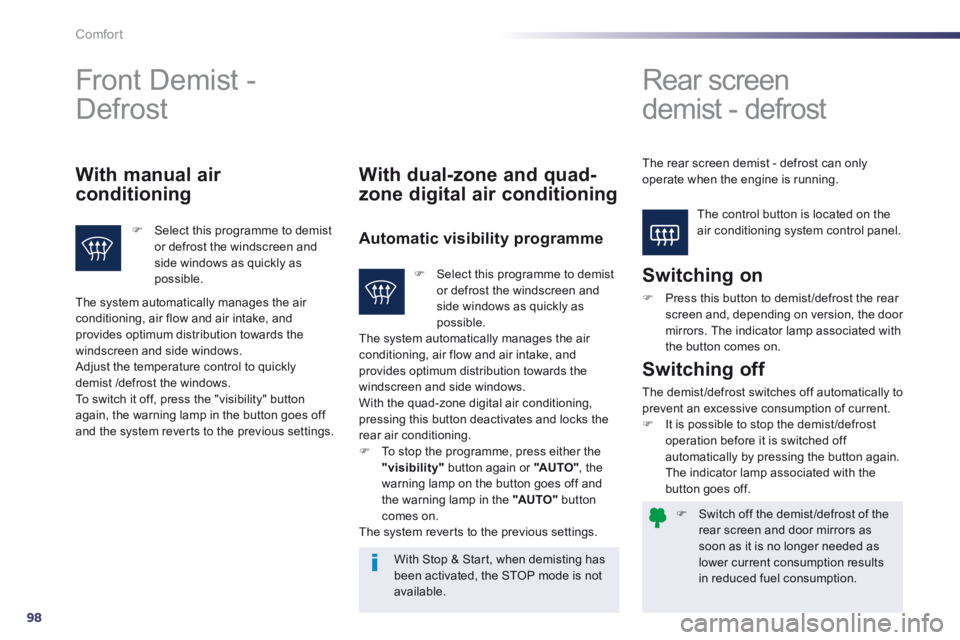
98
Comfort
Switch off the demist /defrost of the rear screen and door mirrors as soon as it is no longer needed as lower current consumption results in reduced fuel consumption.
Front Demist -
Defrost Rear screen
demist - defrost
The control button is located on the air conditioning system control panel.
With manual air
conditioning
Select this programme to demist or defrost the windscreen and side windows as quickly as possible.
With dual-zone and quad-
zone digital air conditioning
Automatic visibility programme
Switching on
Press this button to demist /defrost the rear screen and, depending on version, the door mirrors. The indicator lamp associated with the button comes on.
With Stop & Start, when demisting has been activated, the STOP mode is not available.
Switching off
The demist /defrost switches off automatically to prevent an excessive consumption of current. It is possible to stop the demist /defrost operation before it is switched off automatically by pressing the button again. The indicator lamp associated with the button goes off.
The system automatically manages the air conditioning, air flow and air intake, and provides optimum distribution towards the windscreen and side windows. Adjust the temperature control to quickly demist /defrost the windows. To switch it off, press the "visibility" button again, the warning lamp in the button goes off and the system reverts to the previous settings.
Select this programme to demist or defrost the windscreen and side windows as quickly as possible. The system automatically manages the air conditioning, air flow and air intake, and provides optimum distribution towards the windscreen and side windows. With the quad-zone digital air conditioning, pressing this button deactivates and locks the rear air conditioning. To stop the programme, press either the "visibility" button again or "AUTO" , the warning lamp on the button goes off and the warning lamp in the "AUTO" button comes on. The system reverts to the previous settings.
The rear screen demist - defrost can only operate when the engine is running.
Page 103 of 352
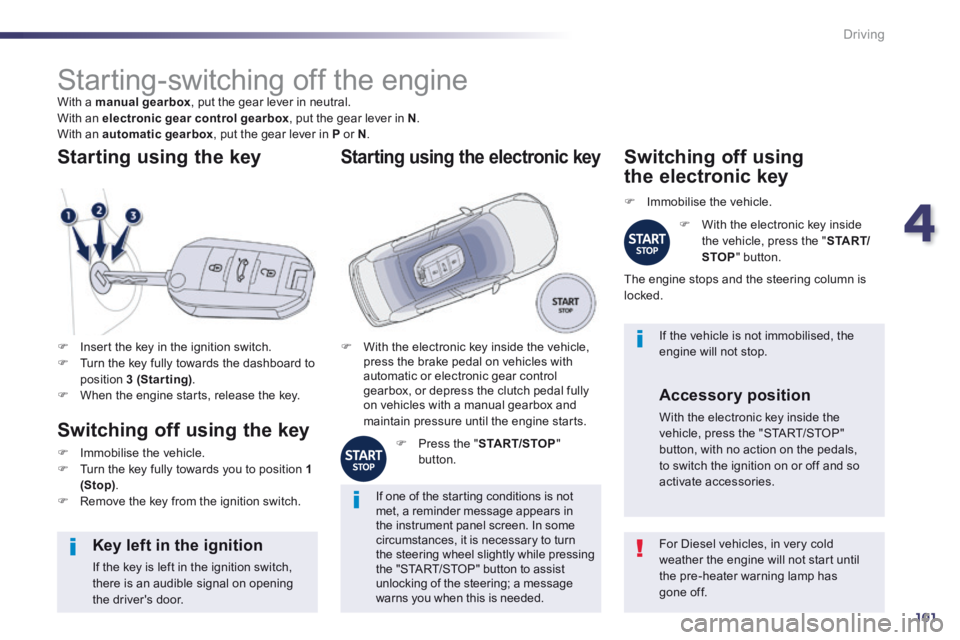
4
101
Driving
Starting-switching off the engine With a manual gearbox , put the gear lever in neutral. With an electronic gear control gearbox , put the gear lever in N . With an automatic gearbox , put the gear lever in P or N .
Insert the key in the ignition switch. Turn the key fully towards the dashboard to position 3 (Starting) . When the engine starts, release the key.
Starting using the key
Switching off using the key
Immobilise the vehicle. Turn the key fully towards you to position 1 (Stop) . Remove the key from the ignition switch.
For Diesel vehicles, in very cold weather the engine will not start until the pre-heater warning lamp has gone off.
Key left in the ignition
If the key is left in the ignition switch, there is an audible signal on opening the driver's door.
If one of the starting conditions is not met, a reminder message appears in the instrument panel screen. In some circumstances, it is necessary to turn the steering wheel slightly while pressing the "START/STOP" button to assist unlocking of the steering; a message warns you when this is needed.
If the vehicle is not immobilised, the engine will not stop. With the electronic key inside the vehicle, press the brake pedal on vehicles with automatic or electronic gear control gearbox, or depress the clutch pedal fully on vehicles with a manual gearbox and maintain pressure until the engine starts.
Starting using the electronic key
Press the " START/STOP " button.
Switching off using
the electronic key
Immobilise the vehicle.
With the electronic key inside the vehicle, press the " S TA R T/STOP " button.
The engine stops and the steering column is locked.
Accessory position
With the electronic key inside the vehicle, press the "START/STOP" button, with no action on the pedals, to switch the ignition on or off and so activate accessories.
Page 104 of 352
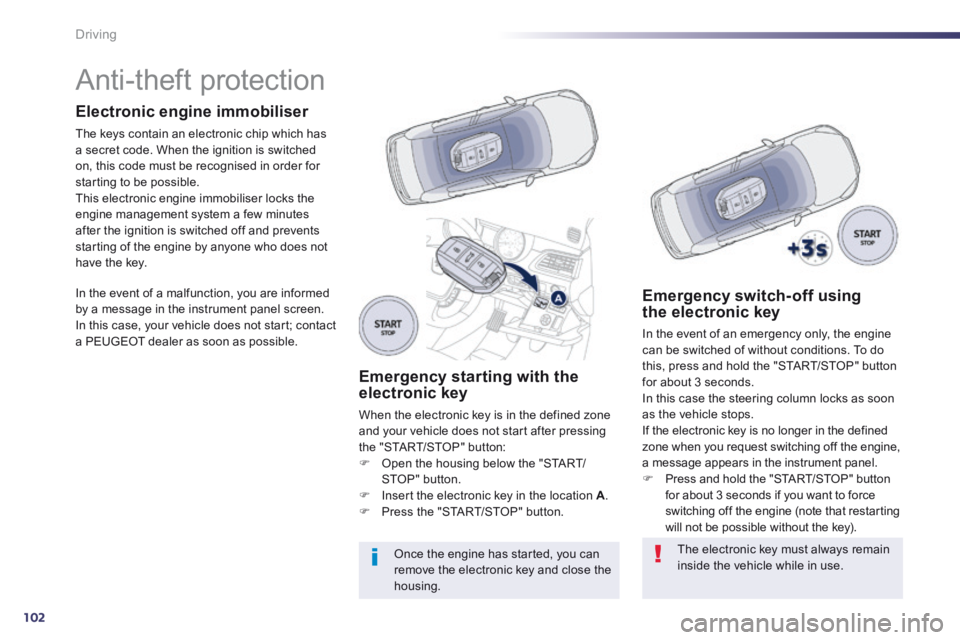
102
Driving
Anti-theft protection
Electronic engine immobiliser
The keys contain an electronic chip which has a secret code. When the ignition is switched on, this code must be recognised in order for starting to be possible. This electronic engine immobiliser locks the engine management system a few minutes after the ignition is switched off and prevents starting of the engine by anyone who does not have the key.
In the event of a malfunction, you are informed by a message in the instrument panel screen. In this case, your vehicle does not start; contact a PEUGEOT dealer as soon as possible.
Emergency starting with the electronic key
When the electronic key is in the defined zone and your vehicle does not start after pressing the "START/STOP" button: Open the housing below the "START/STOP" button. Insert the electronic key in the location A . Press the "START/STOP" button.
Once the engine has started, you can remove the electronic key and close the housing.
Emergency switch-off using the electronic key
In the event of an emergency only, the engine can be switched of without conditions. To do this, press and hold the "START/STOP" button for about 3 seconds. In this case the steering column locks as soon as the vehicle stops. If the electronic key is no longer in the defined zone when you request switching off the engine, a message appears in the instrument panel. Press and hold the "START/STOP" button for about 3 seconds if you want to force switching off the engine (note that restarting will not be possible without the key).
The electronic key must always remain inside the vehicle while in use.
Page 109 of 352
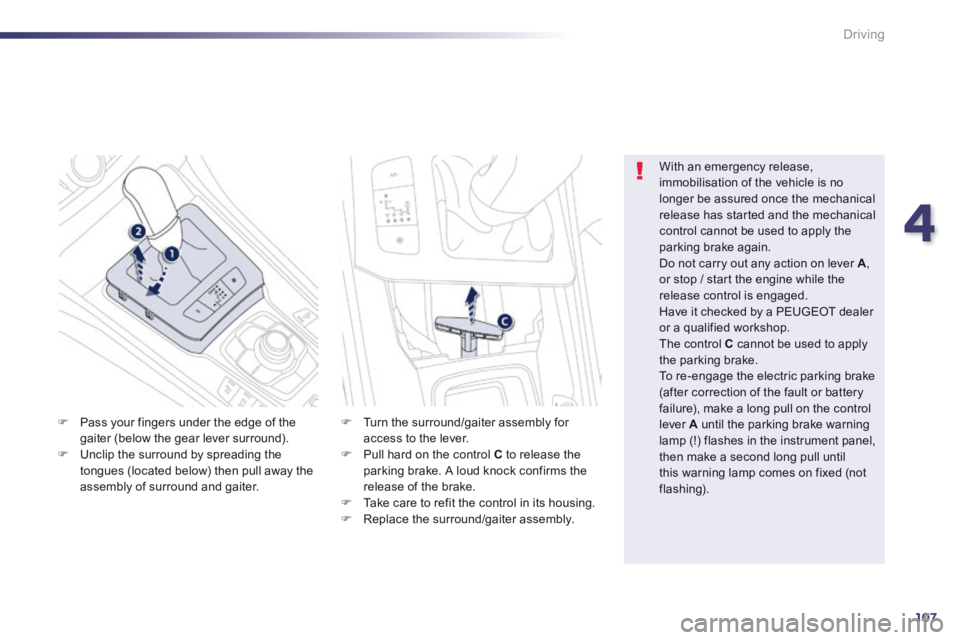
4
107
Driving
Pass your fingers under the edge of the
gaiter (below the gear lever surround). Unclip the surround by spreading the tongues (located below) then pull away the assembly of surround and gaiter.
With an emergency release, immobilisation of the vehicle is no longer be assured once the mechanical release has started and the mechanical
control cannot be used to apply the parking brake again. Do not carry out any action on lever A , or stop / start the engine while the release control is engaged. Have it checked by a PEUGEOT dealer or a qualified workshop. The control C cannot be used to apply the parking brake. To re-engage the electric parking brake (after correction of the fault or battery failure), make a long pull on the control lever A until the parking brake warning lamp (!) flashes in the instrument panel, then make a second long pull until this warning lamp comes on fixed (not flashing).
Turn the surround/gaiter assembly for
access to the lever. Pull hard on the control C to release the parking brake. A loud knock confirms the release of the brake. Take care to refit the control in its housing. Replace the surround/gaiter assembly.
Page 122 of 352
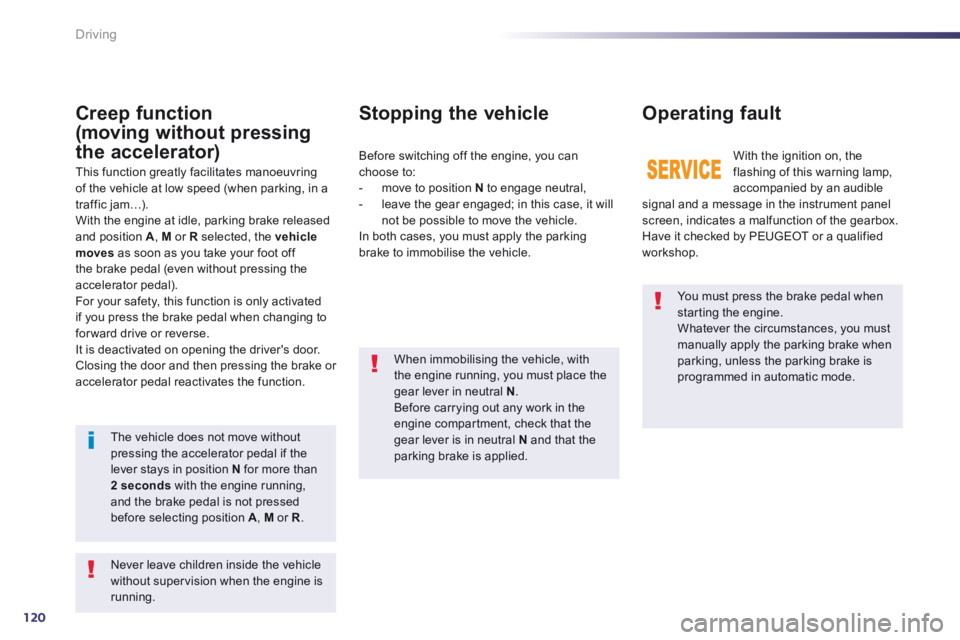
120
Driving
You must press the brake pedal when starting the engine. Whatever the circumstances, you must manually apply the parking brake when parking, unless the parking brake is programmed in automatic mode.
When immobilising the vehicle, with the engine running, you must place the gear lever in neutral N . Before carrying out any work in the engine compartment, check that the
gear lever is in neutral N and that the parking brake is applied.
Stopping the vehicle
With the ignition on, the flashing of this warning lamp, accompanied by an audible signal and a message in the instrument panel screen, indicates a malfunction of the gearbox. Have it checked by PEUGEOT or a qualified workshop.
Before switching off the engine, you can choose to: - move to position N to engage neutral, - leave the gear engaged; in this case, it will not be possible to move the vehicle. In both cases, you must apply the parking brake to immobilise the vehicle.
Operating fault Creep function
(moving without pressing
the accelerator)
This function greatly facilitates manoeuvring of the vehicle at low speed (when parking, in a traffic jam…). With the engine at idle, parking brake released and position A , M or R selected, the vehicle moves as soon as you take your foot off the brake pedal (even without pressing the accelerator pedal). For your safety, this function is only activated if you press the brake pedal when changing to for ward drive or reverse. It is deactivated on opening the driver's door. Closing the door and then pressing the brake or accelerator pedal reactivates the function.
The vehicle does not move without pressing the accelerator pedal if the lever stays in position N for more than 2 seconds with the engine running, and the brake pedal is not pressed before selecting position A , M or R .
Never leave children inside the vehicle without supervision when the engine is running.
Page 123 of 352
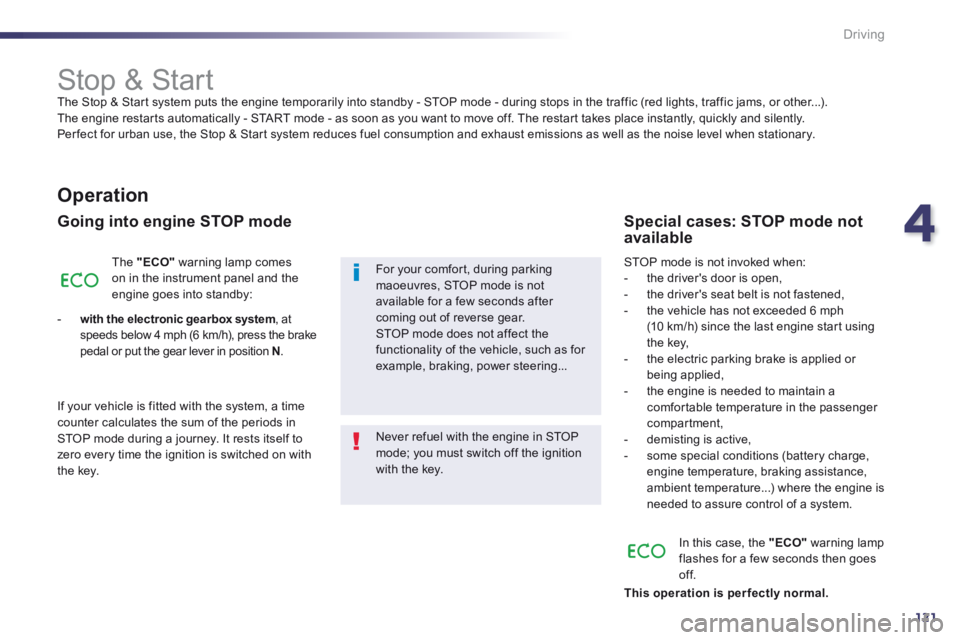
4
121
Driving
Stop & Start The Stop & Start system puts the engine temporarily into standby - STOP mode - during stops in the traffic (red lights, traffic jams, or other...). The engine restarts automatically - START mode - as soon as you want to move off. The restart takes place instantly, quickly and silently. Per fect for urban use, the Stop & Start system reduces fuel consumption and exhaust emissions as well as the noise level when stationary.
Operation
Going into engine STOP mode
The "ECO" warning lamp comes on in the instrument panel and the engine goes into standby:
- with the electronic gearbox system , at speeds below 4 mph (6 km/h), press the brake pedal or put the gear lever in position N .
If your vehicle is fitted with the system, a time counter calculates the sum of the periods in STOP mode during a journey. It rests itself to zero every time the ignition is switched on with the key.
Never refuel with the engine in STOP mode; you must switch off the ignition with the key.
For your comfort, during parking maoeuvres, STOP mode is not available for a few seconds after coming out of reverse gear. STOP mode does not affect the functionality of the vehicle, such as for example, braking, power steering...
Special cases: STOP mode not available
STOP mode is not invoked when: - the driver's door is open, - the driver's seat belt is not fastened, - the vehicle has not exceeded 6 mph (10 km/h) since the last engine start using the key, - the electric parking brake is applied or being applied, - the engine is needed to maintain a comfortable temperature in the passenger compartment, - demisting is active, - some special conditions (battery charge, engine temperature, braking assistance, ambient temperature...) where the engine is needed to assure control of a system.
In this case, the "ECO" warning lamp flashes for a few seconds then goes of f.
This operation is perfectly normal.
Page 124 of 352
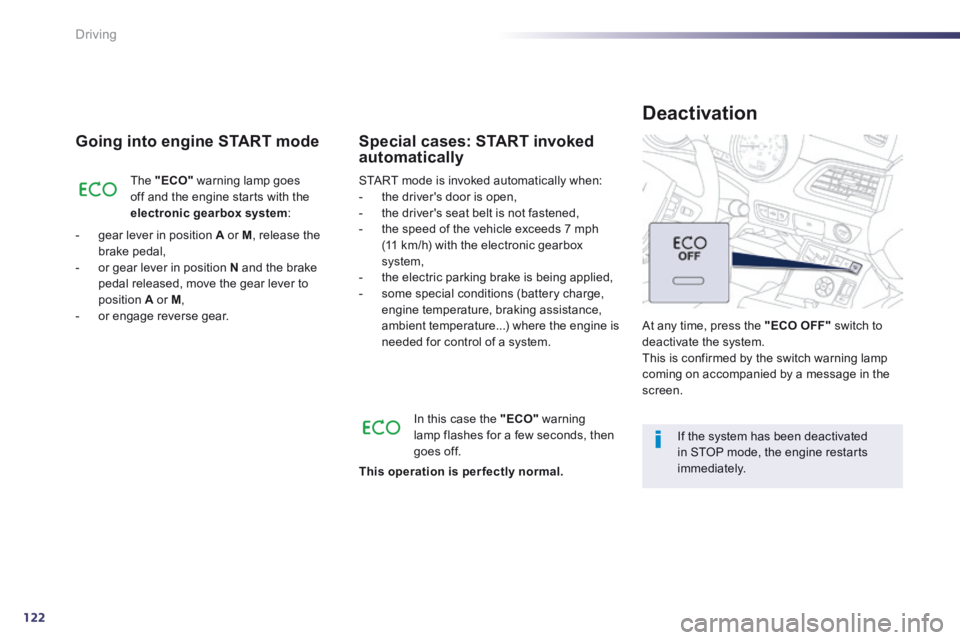
122
Driving
Going into engine START mode
The "ECO" warning lamp goes off and the engine starts with the electronic gearbox system :
- gear lever in position A or M , release the brake pedal, - or gear lever in position N and the brake pedal released, move the gear lever to position A or M , - or engage reverse gear.
START mode is invoked automatically when: - the driver's door is open, - the driver's seat belt is not fastened, - the speed of the vehicle exceeds 7 mph (11 km/h) with the electronic gearbox system, - the electric parking brake is being applied, - some special conditions (battery charge, engine temperature, braking assistance, ambient temperature...) where the engine is needed for control of a system.
Special cases: START invoked automatically
In this case the "ECO" warning
lamp flashes for a few seconds, then goes off. If the system has been deactivated in STOP mode, the engine restarts immediately.
At any time, press the "ECO OFF" switch to deactivate the system. This is confirmed by the switch warning lamp coming on accompanied by a message in the screen.
Deactivation
This operation is perfectly normal.
Page 125 of 352
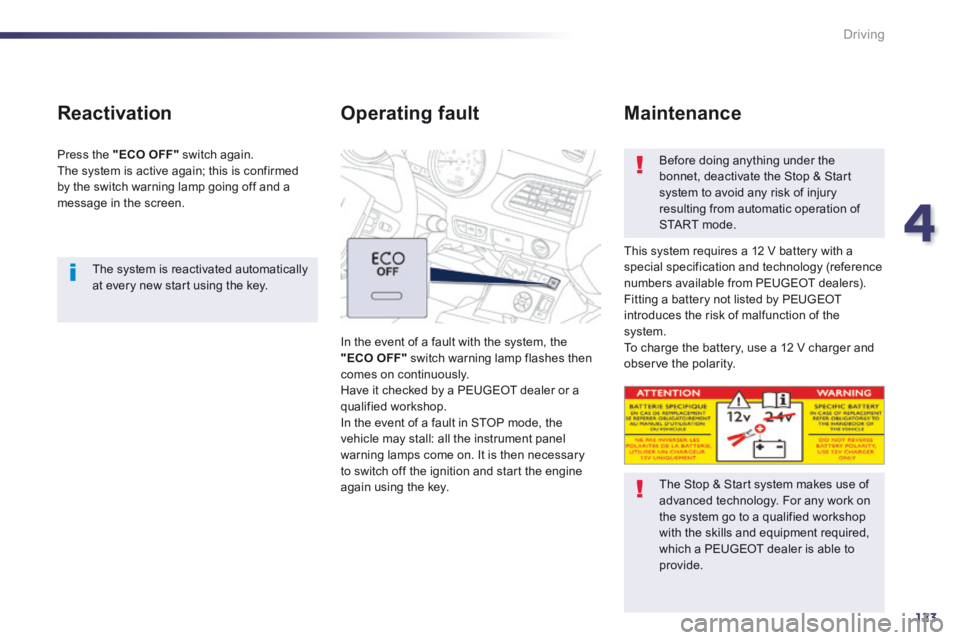
4
123
Driving
The system is reactivated automatically at every new start using the key.
Reactivation
Press the "ECO OFF" switch again. The system is active again; this is confirmed by the switch warning lamp going off and a message in the screen.
Operating fault
In the event of a fault with the system, the "ECO OFF" switch warning lamp flashes then comes on continuously. Have it checked by a PEUGEOT dealer or a qualified workshop. In the event of a fault in STOP mode, the
vehicle may stall: all the instrument panel warning lamps come on. It is then necessary to switch off the ignition and start the engine again using the key.
Before doing anything under the bonnet, deactivate the Stop & Start system to avoid any risk of injury resulting from automatic operation of START mode.
This system requires a 12 V battery with a special specification and technology (reference numbers available from PEUGEOT dealers). Fitting a battery not listed by PEUGEOT introduces the risk of malfunction of the system. To charge the battery, use a 12 V charger and observe the polarity.
Maintenance
The Stop & Start system makes use of advanced technology. For any work on the system go to a qualified workshop with the skills and equipment required, which a PEUGEOT dealer is able to provide.